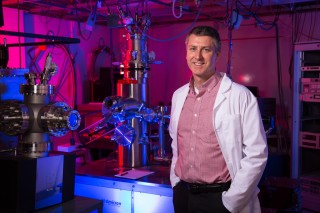A collaborative group of physicists from around the globe has found that the curvature of ripples in freestanding graphene can be controlled by the application of heat. This study provides insight into how temperature affects the dynamics of the two-dimensional material.
 Paul Thibado, University of Arkansas. Credit: Russell Cothren, University of Arkansas
Paul Thibado, University of Arkansas. Credit: Russell Cothren, University of Arkansas
Freestanding graphene holds great promise for applications in microprocessors and advanced energy devices as a substitute for silicon. It may help in development of flexible circuits for consumer electronic devices.
Presently, not much is known about the thermal and mechanical properties of freestanding graphene. In this study, the researchers used thermal load for controlling movements and changes in the curvature of the ripples in this material. Earlier, electric voltage had been used.
University of Arkansas physics professor, Paul Thibado, an expert in experimental condensed matter studies, explained the novel process. Graphene contracts when heated, while most other metals expand. At the nanoscale, the researchers inverted the cross-section of a single wave of freestanding graphene. When this cross-section was heated, it contracted, and buckled in the opposite direction due to thermal stress.
Peng Xu, a former University of Arkansas postdoctoral research associate, led the study. The team of researchers used scanning tunneling microscopy for imaging atoms and molecular dynamic simulations for demonstrating the process of thermal mirror buckling. They have proposed a nanoscale electro-thermal-mechanical device that can modify its output using heat or electricity. This novel device is based on mirror buckling control.
This study, which was led by a University of Arkansas research group, has been published online in the journal Nature Communications.